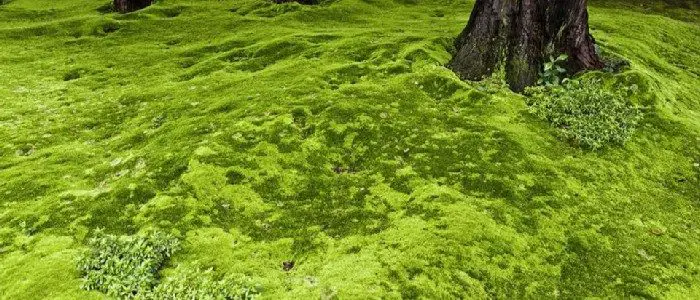We all want to stand out on our patio or deck and admire a lush, green lawn stretching out before us. But when that beautiful color is moss growing instead of grass, that green isn’t nearly as appreciated and raises many questions about why it’s growing in the first place.
The answer to why moss grows in your lawn is simple and yet, not-so-simple at the same time.
In most cases, mosses grow in areas of your yard that are damp, where the grass isn’t thick enough or healthy enough to crowd it out. Unlike other plants, moss lacks a vascular system and true roots. Therefore, moss requires places where there is plenty of water to absorb from the environment to grow and reproduce.
To better understand why moss is in your lawn, we need to discuss the specific conditions that contribute to growth.
The Most Common Reasons Moss Grows In Lawns
High levels of precipitation: Excess precipitation is the leading cause of damp conditions in most climates. When moisture levels are high, moss flourishes. Moisture may come from rainfall, high relative humidity levels, or even areas that accumulate a lot of dew overnight. Keep in mind that if you live in a dry climate, over-irrigation can trigger growth too.
Click the following link to learn more about how rainfall contributes to moss.
Slow-draining soils: Areas in your yard that are slow to drain are a great place for moss to thrive. Soils high in clay content are slow-draining, but any low spot in your yard, whether sandy, loamy, or high in clay, can have poor drainage.
Click the following link to learn more about which soils drain poorly.
Poor air circulation: Too much water isn’t the only reason an area stays damp. Along with having an abundance of moisture, it also needs to have poor air circulation. Evaporation is slower in areas with little air movement, and the soil stays moist, encouraging moss growth.
Click the following link to learn more about how stagnant air can cause moss.
Shaded areas: Shady spots in your lawn are a prime location for moss for two reasons. They are favorable because shade tends to keep the soil damp. Unless you’ve planted shade-tolerant turf, shady spots also tend to have weak grass growth, so they are easy to invade. Keep in mind moss will grow in places with full sun if it’s damp.
Click the following link to learn more about your grass types tolerance to shade.
Faulty lawn care: Improper lawn care doesn’t promote damp conditions but encourages moss growth. When your grass is patchy or weak, moss invades and will take over any space possible. You may unknowingly be encouraging moss growth if you are scalping the grass when mowing, neglecting to fertilize, not performing fall maintenance, or letting weeds grow in the turf.
I go into this in more detail lower on this page, click here to jump to that section.
How To Get Rid Of Moss In The Lawn
Before we look deeper into why moss forms I wanted to point you in the direction of my preferred method for getting moss out of the lawn.
I have used Lilly Miller’s Moss Out a few times in the past and have even used in in video demonstrations on the Turf Mechanic YouTube channel. I currently recommend it to my readers here because it works well and isn’t working via harsh chemical application.
This version of Moss Out uses Ferric sulfate (Iron sulfate) as it’s active ingredient instead of FeHEDTA. It has the potential to stain sidewalks if applied poorly but it should work a bit faster than FeHEDTA with a more complete kill.
You can price out the hose end sprayer version which is what I would use on a larger lawn space through this link that takes you to Amazon’s store.
FYI – DoMyOwn is easily one of the best places to buy lawn and garden products IMO. Much better than Amazon…however, Domyown no longer carries this product.
How To prevent Moss From Growing In The Lawn
Avoiding Poor Lawn-Care Practices
Faulty lawn care might be a pretty major reason behind actually having a moss problem.
If you mow the lawn too close, you might actually end up scalping it.
Again, faulty mowing might also make the lawn uneven and possibly your own laziness might also be the cause. For example, infrequent grass cutting and even not removing the leaves in autumn might actually help the growth of moss in your lawn.
So, one of the first things you need to keep in mind is that you must care about your lawn. Not doing so properly is often one of the main reasons behind the development of moss in your lawn.
This entire website and my entire YouTube channel are devoted to teaching you how to tend to your lawn most effectively. Make sure to start by reading through my guides to lawn care.
Stop Moss From Growing In Shade Zones
One of the leading reasons behind the growth of moss in your lawn is that your lawn might be covered in shade.
Shady places are really favorable for the growth of moss, and that’s precisely why your shady lawn becomes a great place for them to thrive.
If you have a shady lawn that is one of the main reasons why you might be having a moss problem! Areas of your lawn that receive only a few hours of full sun per day is too shady for most residential turf grass types.
If your lawn space is too heavily shaded, you may have to decide which you would prefer, trees/shrubs, mulch beds, or the lawn. If you choose to keep trees or shrubs that cash shade on your problem area then you can cover the area under the trees with a thick layer of mulch.
If you want to maintain a better lawn there then you need to prune overgrow trees around the mossy zone to get more sunlight in and then overseed the area with a dense shade tolerant grass type. In northern locations this is usually a fine fescue but I have an entire article on this site devoted to shade tolerant grass types. Give it a look.
Improve Your Soil To Prevent Moss Growth
Clay soil – the soil that can retain a lot of water – is often a good place for mosses to thrive in.
Soils that hold a lot of water (or where water stands) is often the same places where we find mosses.
Again, a lot of people believe that acidity in soil is one of the factors that really help the growth of moss. And that’s what some of the treatments are based on, by actually making the soil alkaline instead. However I don’t consider this to be a valid concern because moss can grow just fine in both acidic and alkaline soils.
If the environmental conditions are right for moss growth and the grass in the area is weak then moss will start taking over regardless of soil pH.
The biggest influence on moss growth due to soil health is in it’s ability to drain and one of the best ways to get clay soil to drain better is to core aerate and topdress with sand. This will help the soil dry out faster and drain deeper allowing for better root growth in desirable turf.
See this post for more info on core aerating vs spike aerating the lawn.
Better Moisture Management Through Rain & Irrigation
As noted earlier in this article one of the main factors that contributes heavily to the growth of moss is consistently moisture levels in the surface of the soil…and that’s precisely where precipitation and irrigation come into play!
As you know moisture can come in different forms such as morning dew, rain, fog, humidity, and irrigation water. There are quite a few things you might want to consider but the most obvious factor is limiting your sprinkler use during times of high moisture from mother-nature.
Rainfall, overall climate of a region, snowfall, overall precipitation in the form of dew, all of these factors are really important if you consistently get a lot of natural rain then you need to go above and beyond in your attempts to grow moisture loving grass types in your lawn and improve drainage as much as you can through soil amendments.
If you are irrigating too frequently then you need to adjust your schedule accordingly. See the following post for more on watering the lawn without sprinklers.
Improve Micro-Climate Air Circulation In Your Lawn
Precipitation and drainage aren’t the only contributors to damp, always moist soils. Air circulation must also be considered.
Places with proper air circulation don’t really stay damp easily, the moving air or wind will dry out the upper soil surface and limit moss development.
However, places where air circulation is poor, such as next to hedges, fences, or walls can easily become damp and stay damp when excess water enters the soil. These zones of stagnant air flow are perfect places for moss to start growing.
If you have a physical barrier to air flow or wind near a place where moss wants to grow then a good way to fix the problem is to remove or shrink the barrier.
Pruning hedges or shrubs can help, opening up unnecessary fences can help too. In some cases air flow just won’t be able to be changed easily but any improvement you can make will be helpful in managing moss in the lawn.
How to Avoid the Growth of Moss in Your Lawn
The growth of a healthy lawn depends in large extent to the overall conditions of your soil. Having explored the main reasons why moss grows I can’t stress enough that actually actually taking care of your lawn purposefully can go a long way.
If you don’t take care of your lawn properly, you might actually be helping moss to grow there! Alternatively, if you do it properly, you might be able to prevent the growth of moss even in slightly unfavorable conditions. So, doing it properly is the most essential part of your job here!
Learn More About Lawn Care & Put That Knowledge Into Practice
I’ve got a ton of helpful information on this site about lawn care. Check out one or two of the following articles to learn a little bit more.
► Can you Overwater Grass Seed?
► How to Grow Grass on a Steep Hill
► How To Pull Up Grass
► What Humic Acid Does For Grass

